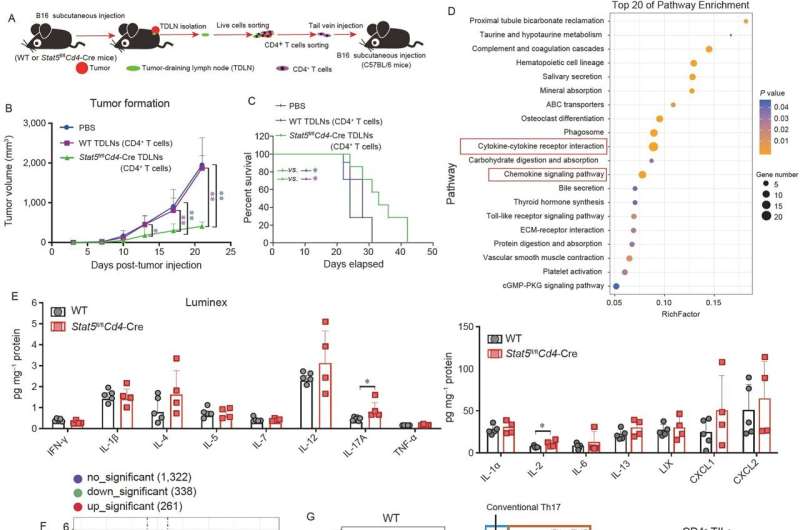Study finds Stat5-/- CD4+ T cells elicit an anti-melanoma effect by CD4+ T cell remolding and Notch1 activation

Tumor-infiltrating lymphocytes (TILs) play a key role in the antitumor immune response and various types of immunotherapies. Recently, studies have shown that CD4+ T cells and CD8+ T cells are equally important for an efficient antitumor immune response, and in specific tumor settings, CD4+ T cell-mediated tumor killing effects can even outcompete that of CD8+ T cells.
Immunosuppressive signals in the tumor microenvironment (TME) can inhibit the infiltration and activity of TILs, while remodeling of CD4+ T cell subsets may alter the cellular components of TILs, thereby enhancing their antitumor immune activity. However, the underlying mechanisms by which CD4+ T cells are involved in reshaping the TME need to be further elucidated.
Stat5, one of the transcriptional factors downstream of common gamma chain (γc) and Janus kinase (JAK), plays a critical role in controlling T cell homeostasis and determining the fate of T cell subsets. However, Stat5 seems to play a more complex role in regulating CD4+ T cell-mediated immune response in different immunologic contexts, raising a concern about how Stat5 acts to boost or repress antitumor immunity exerted by CD4+ T cells in solid tumors.
In a study, led by Prof. Xin-Yuan Fu and Dr. Ke Jin from Laboratory of Human Diseases and Immunotherapies, West China Hospital, Sichuan University, the authors found that subcutaneously inoculated B16 melanoma cells were significantly repressed in Stat5fl/flCd4-Cre mice compared to their wild type (WT) littermates. By performing RNA sequencing to analyze the transcriptomic differences of CD4+ TILs in the melanoma isolated from Stat5fl/flCd4-Cre and WT tumor-bearing mice, they found that Th17-related molecules were significantly enriched in the Stat5fl/flCd4-Cre CD4+ TILs compared to WT CD4+ TILs.
Specifically, they found that a deficiency of Stat5 in CD4+ T cells resulted in increased conventional Th17 cells (IL-17A+ IFN-γ-) and, the unconventional Th17 cells (IL-17A+ IFN-γ+) which resembled the phenotype of Th1 cells in TILs and were defined as Th1-like Th17 cells. They also confirmed that Stat5-deficient CD4+ naïve T cells were prone to polarization of two subtypes of Th17 cells mentioned above, which exhibited increased anti-melanoma activity through enhanced activation of the Notch1 pathway compared to WT Th17 cells.
In conclusion, the current study reveals that Stat5 probably plays a suppressive role in CD4+ T cell-mediated anti-melanoma responses and offers a possibility for targeting Stat5 to develop new T-cell-based antitumor immunotherapy. The research was published in Science China Life Sciences
More information: Ke Jin et al, Stat5−/− CD4+ T cells elicit anti-melanoma effect by CD4+ T cell remolding and Notch1 activation, Science China Life Sciences (2022). DOI: 10.1007/s11427-021-2078-6




















